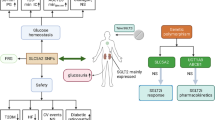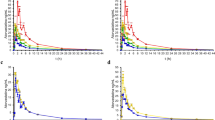Abstract
Purpose
Sipoglitazar was a novel, azolealkanoic acid derivative that possesses selective activity for the peroxisome proliferator-activated receptors (PPAR) PPARγ, PPARα, and PPARδ. The compound undergoes phase II biotransformation by conjugation catalyzed by UDP-glucuronosyltransferase (UGT). The aim of this analysis was to explore the influence of genetic polymorphism in UGT on the pharmacokinetics of sipoglitazar.
Methods
Three preliminary phase I clinical pharmacology studies were conducted in tandem in healthy human subjects. Genotyping was undertaken in a total of 82 subjects in the phase I program for the purpose of genotyping UGT polymorphisms. Plasma samples were collected for up to 48 h post-dose to characterize the pharmacokinetic profile following a single oral dose of the drug.
Results
Plasma concentrations of sipoglitazar and the distribution of dose-normalized individual values for area under the plasma concentration–time curve from time 0 to infinity (AUC0-∞) before any stratification were considerably skewed with a multi-modal distribution. The proportion of variability in AUC0-∞ explained by UGT2B15 was 66.7 % (P < 0.0001); the addition of other genetic or demographic factors was not statistically significant. Subjects homozygous for the UGT2B15 D85Y variant (UGT2B15*2/*2) were exposed to greater plasma concentrations of sipoglitazar than subjects homozygous for the wild-type allele UGT2B15*1/*1 (3.26-fold higher) or heterozygous allele UGT2B15*1/*2 (2.16-fold higher).
Conclusions
These results indicate that sipoglitazar clearance is substantially modified by UGT2B15 enzyme variants, with higher exposure observed in the UGT2B15*2/*2 genotype group.





Similar content being viewed by others
References
Pearson PG, Wienkers LC (2009) Handbook of drug metabolism, 2nd edn. Informa Healthcare, New York
Food and Drug Administration (2008) Table of valid genomic biomarkers in the context of approved drug labels. http://www.fda.gov/Drugs/ScienceResearch/ResearchAreas/Pharmacogenetics/ucm083378.htm. Accessed Feb 2012
Nishihara M, Sudo M, Kawaguchi N, Takahashi J, Kiyota Y, Kondo T, Asahi S (2011) An unusual metabolic pathway of sipoglitazar, a novel anti-diabetic agent: cytochrome P450-catalyzed oxidation of sipoglitazar acyl glucuronide. Drug Metab Dispos 34:1220–1228
Newton CR, Graham A, Heptinstall LE, Powell SJ, Summers C, Kalsheker N, Smith JC, Markham AF (1989) Analysis of any point mutation in DNA. The amplification refractory mutation system (ARMS). Nucleic Acids Res 17:2503–2516
Guillemette C (2003) Pharmacogenomics of human UDP-glucuronosyltransferase enzymes. Pharmacogenomics J 3:136–158
Chung JY, Cho JY, Yu KS, Kim JR, Jung HR, Lim KS, Jang IJ, Shin SG (2005) Effect of the UGT2B15 genotype on the pharmacokinetics, pharmacodynamics, and drug interactions of intravenous lorazepam in healthy volunteers. Clin Pharmacol Ther 77:486–494
Girard H, Villeneuve L, Court MH, Fortier LC, Caron P, Hao Q, von Moltke LL, Greenblatt DJ, Guillemette C (2006) The novel UGT1A9 intronic I399 polymorphism appears as a predictor of 7-ethyl-10-hydroxycamptothecin glucuronidation levels in the liver. Drug Metab Dispos 34:1220–1228
Gagne JF, Montminy V, Belanger P, Journault K, Gaucher G, Guillemette C (2002) Common human UGT1A polymorphisms and the altered metabolism of irinotecan active metabolite 7-ethyl-10-hydroxycamptothecin (SN-38). Mol Pharmacol 62:608–617
Levesque E, Delage R, Benoit-Biancamano MO, Caron P, Bernard O, Couture F, Greenblatt DJ (2007) The impact of UGT1A8, UGT1A9, and UGT2B7 genetic polymorphisms on the pharmacokinetic profile of mycophenolic acid after a single oral dose in healthy volunteers. Clin Pharmacol Ther 81:392–400
Court MH, Hao Q, Krishnaswamy S, Bekaii-Saab T, Al-Rohaimi A, von Moltke LL, Greenblatt DJ (2004) UDP-glucuronosyltransferase (UGT) 2B15 pharmacogenetics: UGT2B15 D85Y genotype and gender are major determinants of oxazepam glucuronidation by human liver. J Pharmacol Exp Ther 310:656–665
Zhang JY, Zhan J, Cook CS, Ings RM, Breau AP (2003) Involvement of human UGT2B7 and 2B15 in rofecoxib metabolism. Drug Metab Dispos 31:652–658
Rauchschwalbe SK, Zuhlsdorf MT, Wensing G, Kuhlmann J (2004) Glucuronidation of acetaminophen is independent of UGT1A1 promotor genotype. Int J Clin Pharmacol Ther 42(2):73–77
Krishnaswamy S, Hao Q, Al-Rohaimi A, Hesse LM, von Moltke LL, Greenblatt DJ, Court MH (2005) UDP glucuronosyltransferase (UGT) 1A6 pharmacogenetics: II. Functional impact of the three most common nonsynonymous UGT1A6 polymorphisms (S7A, T181A, and R184S). J Pharmacol Exp Ther 313:1340–1346
de Wildt SN, Kearns GL, Leeder JS, van den Anker JN (1999) Glucuronidation in humans. Pharmacogenetic and developmental aspects. Clin Pharmacokinet 36:439–452
Gsur A, Preyer M, Haidinger G, Schatzl G, Madersbacher S, Marberger M, Vutuc C, Micksche M (2002) A polymorphism in the UDP-Glucuronosyltransferase 2B15 gene (D85Y) is not associated with prostate cancer risk. Cancer Epidemiol Biomarkers Prev 11(5):497–498
Stringer F, Ploeger BA, DeJongh J, Scott G, Urquhart R, Karim A, Danhof M (2012) The impact of UGT polymorphism on the pharmacokinetics and pharmacodynamics of the novel PPAR agonist, sipoglitazar. J Clin Pharmacol. doi:10.1177/0091270012447121
Acknowledgments
The authors would like to thank Judith Wallace for her editorial assistance and Anil Sekhari and Diana Stuart for their support and expertise on the production of the graphical displays.
Conflict of interest
F.S, R.U, and M.N are employees of Takeda Pharmaceutical Company, and G.S, M.V, and J.K are employees of Takeda Global Research & Development, Inc.
Author information
Authors and Affiliations
Corresponding author
Rights and permissions
About this article
Cite this article
Stringer, F., Scott, G., Valbuena, M. et al. The effect of genetic polymorphisms in UGT2B15 on the pharmacokinetic profile of sipoglitazar, a novel anti-diabetic agent. Eur J Clin Pharmacol 69, 423–430 (2013). https://doi.org/10.1007/s00228-012-1382-7
Received:
Accepted:
Published:
Issue Date:
DOI: https://doi.org/10.1007/s00228-012-1382-7




